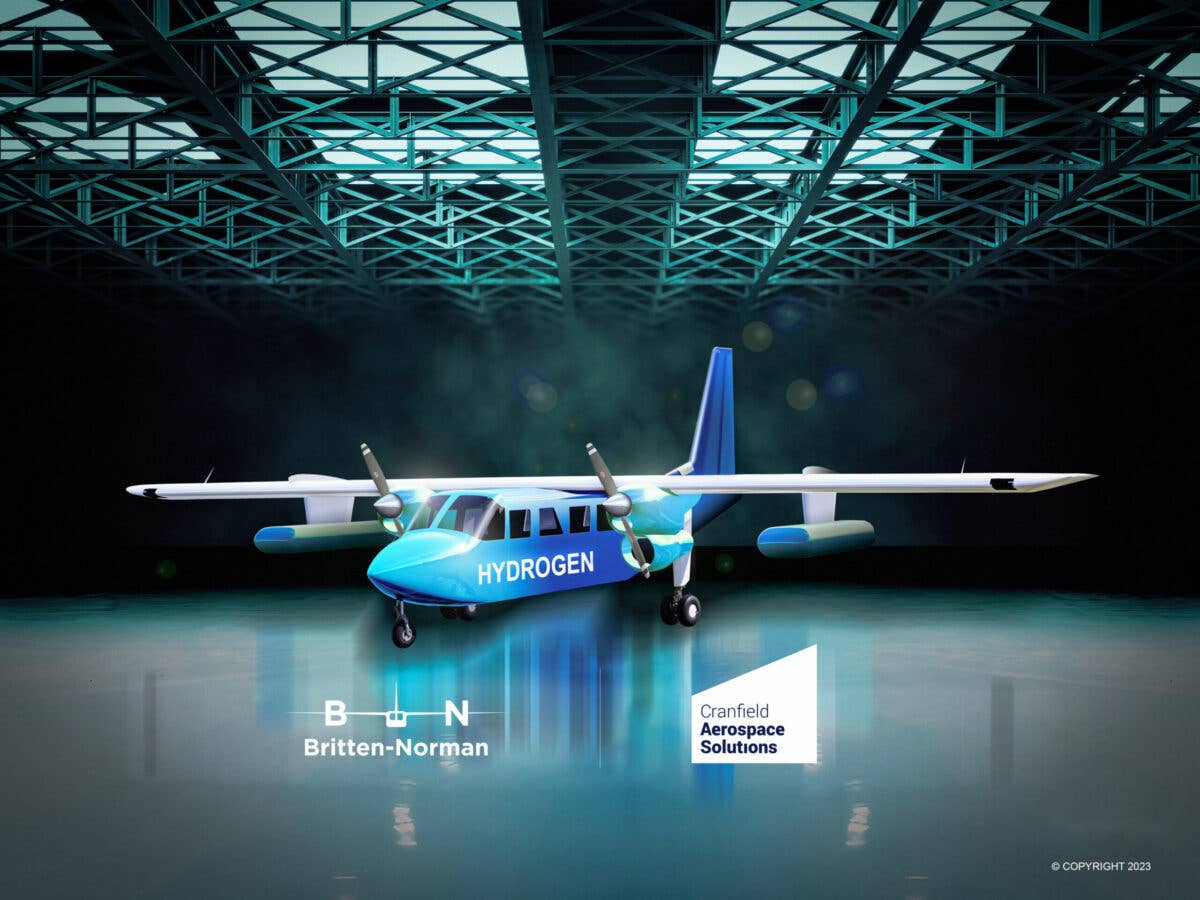Britten-Norman, Cranfield Aerospace To Merge in Pursuit of Hydrogen Fuel
The two British firms are eyeing hydrogen-powered regional, transport-category jets by 2026.

A concept image of Britten-Norman and CAeS’s hydrogen-powered Islander model. [Credit: Britten-Norman]
A proposed merger between a pair of British firms—one a longtime aircraft manufacturer and the other a pioneer in alternative propulsion systems—could hold the key to an aviation first.
The U.K.’s Britten-Norman and and Cranfield Aerospace Solutions (CAeS) last week signed a heads-of-terms agreement outlining a merger that is expected to be completed in mid-2023, clearing the way for the companies to launch a hydrogen-powered regional transport-category jet by 2026.
To achieve that, the combined entity’s near-term focus will be achieving certification for hydrogen-powered models of Britten-Norman’s nine-seat Islander, one of the best-selling commercial airliners in Europe. The current model is used primarily to complete short-range commercial passenger service.
Now, the new firm is looking to complete those same flights using CAeS’s hydrogen-electric fuel cell propulsion technology to power Britten-Norman’s airplanes. It will replace the Islander’s piston and turboprop engines with fuel cells and electric motors that run on gaseous hydrogen, which CAeS says is easier and cheaper to manufacture despite having a lower range than its liquid alternative.
The idea here is that Britten-Norman, the sole manufacturer of passenger-carrying airlines in the U.K., will create “a clear and unambiguous route to market” by becoming one of the world’s first OEMs of hydrogen-powered aircraft.
“[It] will create a new market leader in green aircraft manufacturing, bringing together joint strengths in aerospace manufacturing, certification, and innovation,” said Willian Hynett, CEO of Britten-Norman. “The investment will give a huge boost to U.K. aviation exports and will deliver the first OEM sub-regional aircraft powered by hydrogen.”
The proposed merger also calls for HydrogenOne Capital Growth Plc—a who’s who of CAeS investors including Hydrogen One, Safran Corporate Ventures, and the UAE government-backed Strategic Development Fund—to put as much as $12.5 million into the new firm.
That follows an $18 million raise supported by Motus Ventures and the UAE’s Tawazun Economic Council, much of which has gone toward Project Fresson, a U.K. government-backed initiative to equip the Islander with a hydrogen propulsion system.
“This deal accelerates our roadmap for the introduction of new zero-emissions aircraft,” explained Paul Hutton, CEO of CAeS. “As other sectors decarbonise quickly, it is imperative that the aviation industry accelerates its own transition to new, clean aircraft. Looking to the future we will use the combined experience of Cranfield Aerospace and Britten-Norman to produce an entirely new aircraft design, optimized around hydrogen fuel cell technology.”
According to Britten-Norman and CAeS, the deal comes as airlines and operators increasingly demand an OEM-backed, zero-emissions aircraft.
That’s because they’re under immense pressure to reduce their carbon footprint.
The U.S., for example, is targeting net-zero greenhouse gas emissions for the aviation sector by 2050. As things stand, the sector globally is expected to produce 2.5 percent to 25 percent more carbon emissions by then. And in the U.K., where Britten-Norman and CAeS are based, air travel is projected to account for almost 39 percent of all carbon emissions by 2050.
But according to experts, a path to net zero by 2050 is possible. Some have come up with a proposed solution: fly less. Many others, though, believe that a mix of sustainable aviation fuels and alternative propulsion methods—like hydrogen—can get us there.
Already, aviation stakeholders are laying the groundwork for a hydrogen-powered future as a possible answer. Large European firms like Airbus and British Airways have publicly announced initiatives to add hydrogen fuel systems to their fleets. To support those flights, hydrogen powertrain maker ZeroAvia partnered with France’s Absolut Hydrogen to build infrastructure for liquid hydrogen fueling.
Meanwhile, in the U.S., Universal Hydrogen, a startup backed by both American Airlines and JetBlue, recently completed a successful 15-minute test flight of an airplane with one conventional engine and one hydrogen-powered engine (aptly named “Lightning McClean”).
Elsewhere, a trio of Korean firms—Ultra Safe Nuclear Corp., SK Ecoplant, and Hyundai Engineering—signed a MOU to research and eventually build out a network of “hydrogen micro hubs.” The micro-production centers would rely on nuclear power, rather than greenhouse gas-producing methods like steam reformation, to make hydrogen fuel.
Still, much more work is needed to create the infrastructure required for sustainable, hydrogen-powered aviation, particularly around fueling and storage. One concern is that the manufacturing and storage of hydrogen fuel would increase emissions from sectors like production and transportation.
That said, Britten-Norman and CAeS have an opportunity to move the aviation industry toward a zero-emission future. The combined entity’s early test flights could serve as a petri dish, allowing it to experiment with fueling and storage methods until it finds something that sticks.

Subscribe to Our Newsletter
Get the latest FLYING stories delivered directly to your inbox






